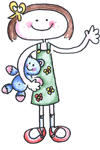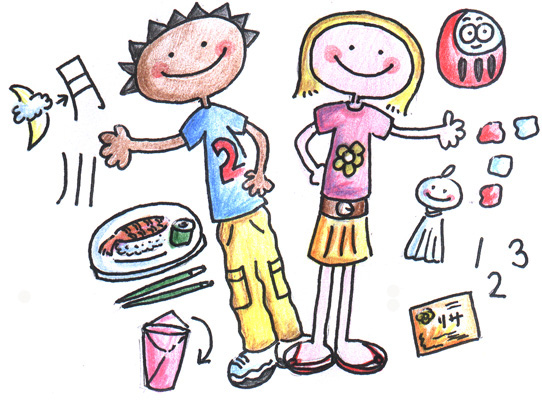Lesson 2
Lesson Plan Download pdf
Main (20 minutes)
Review of the greetings and conversations from lesson one.
Model the following conversation:
| A: | nan sai desu ka | 何さいですか | How old are you? |
| B: | watashi wa … sai desu. | 私は…さいです。 | I am … years old. |
Ask the children if they can guess what has been said. Can they recognise any of the words? (Perhaps hint that they should be listening for numbers).
Grammar note
‘ka’ shows that a question has been asked – it acts like a question mark,
‘sai’ means ‘years’, ‘nan’ is an interrogative word (who, what).
Ask the children how old they are. You will need to explain that some of the numbers sound slightly different when you add ‘sai’ (years(old)).
| issai | いっさい | 1 year old |
| nisai | にさい | 2 years old |
| sansai | さんさい | 3 years old |
| yonsai | よんさい | 4 years old |
| gosai | ごさい | 5 years old |
| rokusai | ろくさい | 6 years old |
| nanasai | ななさい | 7 years old |
| hassai | はっさい | 8 years old |
| kyusai | きゅうさい | 9 years old |
| jussai | じゅっさい | 10 years old |
| juissai | じゅういっさい | 11 years old |
| junisai | じゅうにさい | 12 years old |
Practise with the children and have them practise with one another too. You could sit in a circle and the children take it in turns to ask one another how old they are.
Use flash cards to introduce different family members. Children only need learn those family members which are applicable to them (although if they can learn more, all the better!):

| otosan | おとうさん | dad |
| okasan | おかあさん | mum |
| onisan | おにいさん | older brother |
| onesan | おねえさん | older sister |
| ototo | おとうと | younger brother |
| imoto | いもうと | younger sister |
Note: step father and step mother are still commonly referred to okasan and otosan.
Language Awareness Point
Ask children what they think the suffix, ‘san’ means. Explain that it is a
marker used to show respect. So even when referring to people by name,
san will always be added (unless it is a close friend). Mr Mughal for
example would become Mughal san. Note: you should never refer to
yourself as ‘san’. It is a term which shows respect to whom you are talking
to, not yourself!
As more affectionate terms, children can attach ‘kun’ or 'chan' to other children's names. Generally, kun is used for boys and chan for girls, so Matt would be ‘Matt kun’ and Nadiya would be 'Nadiya chan'.
Have the children sit together and throw a ball to one of the children. When they receive the ball, they have to state all the members of their family. The ball then returns to the teacher and the activity continues.
